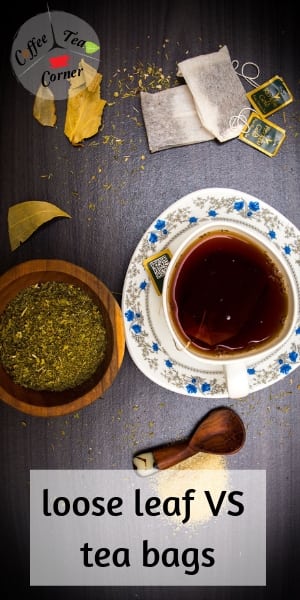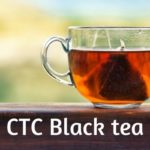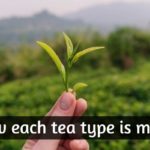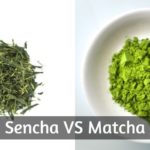Ever since tea became popular, the debate of loose-leaf vs bagged tea sprung up and hasn't died down since. And for good reason, since the two tea types really do give different results.
I'm sure there are people out there who swear by loose-leaf tea, and there are people out there who love their boxes of bagged teas. It depends on what you're looking for in a tea, I'd say, and how specific or fussy you want to be about it. Let me explain.
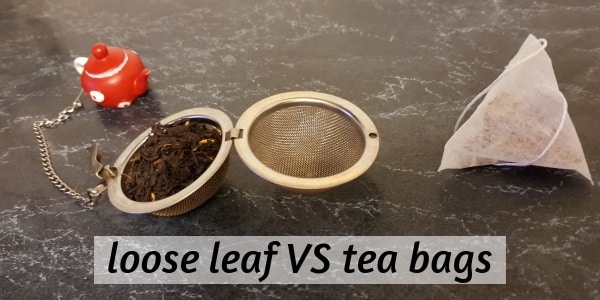
Table of Contents
Both loose leaf tea and tea bags have their own place in the world
There's a reason both loose-leaf and bagged tea have stuck around so long. When the West first encountered tea, is wasn't in a bag. It was brewed in a pot, the loose leaves carefully selected.
But for the common folk, who happened to be fairly busy, sitting around for tea wasn't the most convenient. So placing the tea in small bags to infuse became a sort of hack, and it stuck.
It also was a wonderful way to use up all the broken bits of tea leaves that remained after processing the tea. This may or may not have been the true reason for the rise of bagged teas.
The tea industry's not telling, and in the end does it really matter ?
In the end, most of us have grown up with tea bags, I think. Whether it was actual Camellia sinensis tea, or herbal tea, or a blend between the two, those teabags are fond memories for many people.
There is a certain charm about brewing your own loose leaves into the perfect infusion, and sitting down to enjoy it.
Seeing as we're so many people and of so many tastes, I think there's room for everyone. Let's look at the loose leaves a bit closer.
Loose leaf teas have a history and tradition
Loose leaf tea is the first form of tea, and it's a well know and respected tradition of brewing tea. The whole point of the tea infusion is to brew out the flavor and nutrients found in the tea leaves.
A whole, full leaf will allow that to happen in a much better and full way than a broken tea leaf in a bag. Ever since tea was first brewed, the process of drying and roasting and steaming the leaves has been perfected.
The tea plant itself has been planted and cared for in very specific ways, and this influences the final flavor of your cup of tea. On a tea bag, this is lost since the tea will taste fairly flat.
Back to the loose leaves, you will generally find loose leaf teas to be of finer quality, better processing, and tasting much better than bagged tea.
It's got to do with how well the water travels through the leaves. This releases the flavor much better, and draws out the tannins that the teas are famous for.
Then there is the tradition and ritual of boiling the water and adding it over the tea leaves, letting them steep, and then serving the tea. It's a very relaxing process, and it's a great way to bond with friends and family since it requires you to be calm and focused.
Time seems to...slow down when you're making tea. You can enjoy it better, and there are whole ceremonies dedicated to this in the East.
Usually a loose leaf tea will cost more than its bagged counterpart. This is because the loose leaves both release more flavor, and are harder to maintain in their full unbroken form.
Even when the tea is not made of Camellia sinensis leaves, but is a herbal tea, it's still much better when you've got the full herb and not just a few crushed dried leaves.
But, there are uses for the bagged tea, and it has its merits. Let's talk about that for a bit.
Bagged teas are convenient and fast
Tea bags are part of most kitchens, I think. When I was in college tea bags were the only tea I had, since a loose leaf tea was a treat for me. Still, the tea bags were quick, they were easy to brew and they could be very easily discarded.
If there was one thing I hated (and still do) about loose leaves is those extra steps of getting rid of them.
My affinity for tea became a bit of a joke between my friends because I'd always have 10-14 tea boxes with all the teas possible stocked up. All tea bags, of course.
I'm sure many people are or were or will be in the position I was. Not really affording to spend much on a loose leaf tea, and would like a cup of tea right now, thank you.
The tea bags are a fast way to get a cup of tea, and in many office break rooms it's what you're going to find instead of loose leaves.
There's also the case for tea bags being easier to store, and keep secure in an airtight envelope that lets no light in as well.
If you're wondering why a tea bag infuses so much quicker, but tastes plainer than leaves, let me explain.
It actually has to do with what's in the tea bag itself. This means that the bag contains bits of tea leaves that have broken off during the processing of the leaves. There's also tea dust, which is just dry tea leaves that have broken into pieces so tiny they're now dust.
So it's also a way to cut losses for the tea industry as well.
One major plus I find with tea bags is that they keep the tea dust and small bits very well inside. If you've ever made yourself a cup of loose leaf tea, you've probably noticed some broken bits of tea leaves on the bottom of your cup.
In a way, I'd guess choosing loose leaves over tea bags is a bit like grinding your own coffee instead of getting them pre-ground. It's an extra hassle, but for quite a number of people it's worth it.
The two kinds of teas give different infusions
Alright, so now we've seen the case for both tea types. Let's see why they give different infusions, though. After all, they're the same plant and as such should give you very similar (if not the same) brews.
Well, no. The thing is that a loose leaf, especially one that isn't restrained in a tea bag or tea ball has room to expand fully. The water can get into every nook and cranny and extract everything the tea has to offer.
This is why crowding the tea ball is not a bright idea (I've been so guilty of this), since the water won't get into the leaves very well, even if they do soak up some water. It's a good way to reuse the leaves though, for a second steeping.
So if a crowded tea ball is inferior to a tea brewed into a whole pot, what about tea leaves put in a large tea bag and left in the pot ? Easier to clean up and no mess.
You can always use some coffee makers to brew tea just as well as a pot.
Well, there the bag itself will retain a bit of the flavor of the tea, and in some sad cases give your entire tea a whole paper-like taste. You know what I mean.
So what about the small tea bags from the supermarket ? The same applies to them, since they're bags after all. Sometimes they can leave a bad taste in the infusion.
This depends on the material the bags or satchels are made out of. Some are made out of high quality tea paper, some are silk satchels, and some are just plain... wrong. The yellowish, fuzzy kind of porous paper.
But the real reason tea bags are not a good idea is because the small bits of tea leaf won't provide the whole experience that the entire leaf will.
The resulting infusion is often flat, a bit weak even, and you won't notice the different nuances in your tea unless they're hammered into your cup with added flavorings.
The tea bag infuses faster (2 minutes most times) since the actual surface of the bits of leaves is smaller and as such releases everything faster.
The kind of tea bag you have is a marker of quality
If you need to remember one thing, remember that most tea bags are almost like the instant coffee of teas. Convenient, fast, but never the real thing.
That being said, not all tea bags are alike. Some can be of high quality, and contain not just tea dust. You'll notice some bags are made from that very plain tea paper.
For the most part, these don't leave an odd taste in your tea, and they feel fairly stiff to the touch if you inspect them. They hold up well enough in the brew and if you ever try to wring them (I did) they might break.
Those are the most common tea bags out there, and they're usually filled with broken bits of tea and the resulting dust. You might sometimes find/see bits of herbal tea in your bag, depending on what kind of tea you have.
Onto the next kind of tea bag, the silk satchels. These are often a pyramid shape, sometimes in the shape of a usual tea bag. Their advantage is that they let water flow through more easily, and they give your tea no funny flavor.
As for the silk part, most often it's a very thin, very finely spun plastic thread. This isn't an issue in terms of flavor, but it's definitely not silk, is it ?
The pyramid types are supposed to contain larger bits of tea leaves, and definitely no tea dust. Sometimes they actually do contain higher grade tea, and that can justify the price for this kind of packaging.
Sometimes though, people have bothered to open up a pyramid and a regular tea bag from the same company and found the exact same tea. Not all companies do this, but it's good to be aware of what to look out for.
Then there are the tea bags that have been wrapped in an opaque, airtight envelope. Often it's plastic, and it's meant to keep the tea as fresh as possible. Those are better quality teas, simply because more care has been taken in regards to freshness and attention to detail.
So there are tea bags and tea bags. After all, tea preference is pretty much trial-and-error so you might have to look around a bit for the perfect packaging method for you.
(If you like this article so far, you can pin it to your Pinterest board by clicking the image below. The article continues after the image.)
Serious quality problems can come up with bagged teas
For example a plain black tea with lemon would have in the bag some broken black tea leaves, which were infused with lemon oil beforehand, and possibly a few small bits of lemon zest.
That would be indeed what's said on the packaging: black tea with lemon.
But there is a very silly tea at my workplace's break room, and it's meant to be a raspberry tea. It says so on the box. When I turned it over to the ingredients the first few were hibiscus, apple, and rosehip. Raspberry was there indeed, but marked as 3%.
Inside the bag I could see raspberry seeds and other bits of herbal/fruity tea. I doubt the seeds were what gave the tea the raspberry flavor.
But, it does needs to look like it's got the ingredients, no ?
Again, not every tea company is guilty of this. Some actually have some very good quality ingredients, and you can actually see the bits of vanilla or roe petal (or other ingredients listed) inside the little bags.
Still, remember that there are teas out there that can be misleading if you don't check the ingredients carefully. Most low-end teas give no attention to details and quality.
Source and flavor-profile are easy to trace with loose-leaf tea
When it comes to loose-leaf tea the source of the tea is usually stated on the packaging. For example the tea house I get my teas from have a booklet which lists all the teas they have available for sale for a two year period.
You'll find the tea type, country of origin, ingredients, and price per 100 gr/3.5 oz.
This is easier to do with loose leaf tea because they fetch a higher price. And for a higher price, customers will want to be very sure about what kind of tea they're getting, and from where.
Another interesting this to note is that many places in the world offer different notes in their teas, depending on the year (climate and pollution levels), and the season as well.
So in most cases loose leaf teas are going to be of higher quality, and you will be able to enjoy it kind of like a wine.
As in a green tea collected a year ago might have a different aroma than one collected last month, because of the different climate conditions that were present in that particular tea farm a year ago.
There is also the case of where each tea type comes from. This is obvious in cases like the Gyokuro teas - which are Japanese green teas, grown and processed only in Japan. They are the same leaves the Matcha is made from, only the process is a bit different.
Assam teas are black teas grown in the region of Assam, India. These are the bolder black teas, and they're often found in breakfast teas and do contain caffeine.
So an Assam tea with bergamot flower oil will be an Earl Grey. That's the famous English tea, and now you'll remember this when you seem a box of Earl Grey in the supermarket.
It might sometimes contain other black tea types than just Assam, but that is the most common one in breakfast teas.
There are compromises, like large tea bags or tea balls
You might be wondering what you can do if making tea in a tea pot is not your thing. As in, letting the leaves unfurl on their own, and straining your the tea into your cup.
Well, there's several things you can try. I'll get into detail with each of them, and you can pick what you think would be best for you.
Tea balls are simple to use and clean
This is what I actually use, and it's up to you if you like this style or not. I did mention a few paragraphs ago that tea brewed in a tea ball is inferior to tea brewed on its own in a pot.
White that is true, for me this is the best compromise. For the most part because of the ease of letting the tea steep as long as it needs, and then I can just remove the ball and enjoy my tea.
Every kind of method described here is going to require you to either clean the infuser or mind dripping from the tea bag. But for me the tea ball is the simplest way to enjoy loose leaf tea.
Sometimes they are tea balls, sometimes they look a bit like tongs and the open and close like a scissor, sometimes they look like little boxes. The principle is the same.
What you have to be careful about is to add sugar or milk only after you're done brewing the tea and have removed the ball from the cup/mug.
This is because they can slowly eat away at the metal and this will ruin your tea.
For example this tea infuser is not a ball, but looks more like a cup and is easy to use. It's actually a set, one for a single cup of tea and one for a whole pot of tea (or 2-3 cups at a time).
I recommend cleaning the infuser immediately after brewing the tea, even if it is stainless steel. In time it can change its appearance because of the tannins in the tea.
You can check the listing on Amazon for this tea infuser here, and read the reviews as well.
Large, empty tea bags are a quicker option
I've used large tea bags before, and I have to admit that I hate the dripping more than cleaning the tea ball. But if you don't mind the few drops of water that seep through the tea bag out of the pot, then maybe this is for you.
Just make sure you have a good method of securing the tea bag in the pot so it doesn't slip away.
I have to admit that a large tea bag is much easier to use than a tea ball, and it will be easier to discard as well. If you're planning on reusing the tea leaves the bag will keep them a bit better an a tea ball, so take that into account as well.
A bit of the tea's flavor can get trapped in the bag's fibers, but not enough to impact your overall brew.
Add the fact that a tea bag like this one can be filled with as little or as much tea as you like, and it can become a quick favorite.
This particular tea set has 100 bags, so that's at least 100 cups of tea if you're only using the tea leaves once. And it also comes with a cute clip you can attach to the bag's drawstring so it won't float away in your cup or pot.
You can check the listing on Amazon for this one here, and read the reviews as well.
Tea infuser mugs are pretty much the best
This is what many tea houses will bring you the tea in. In a way, it really is the best way to enjoy tea. As in there's a lid, so no moisture escapes ad your brew stays the right temperature and strength.
The infuser itself is part of the mug, and it removable as well, which gives the tea more time to steep, and lots of space to unfurl. I think that's its greatest advantage.
One small disadvantage is that you can't fill your cup with as much water as you'd like the final brew to be, because you have to allow space for the liquid to rise when you add the infuser.
So basically if you add as much water as you think would normally be necessary, it will be too much and your cup will overflow. This is why many such mugs are just so damn large.
For example this one is not only cute, but you can also pick whichever pattern or color you like. I'm showing you here my favorite.
And it's large enough to give you a decent sized cup of tea. Once you're done brewing, simply turn the lid on its back, and put the infuser (let it drain) on the lid so avoid any mess.
You can reuse the tea leaves with such an infuser, yes.
And you can check the listing on Amazon for this mug here, and read the reviews as well.
Final thoughts
In the end when you pick your tea, you should make sure you're comfortable with the flavor itself. Whether it comes in a bag or in loose leaves does matter, but the decision is up to you.
I recommend you try a loose leaf tea at least one if you've never had one before. You'll notice a clear difference, and you'll know if you like the idea or not.
If you're already on the loose leaf side, then remember to not be too harsh with those to like their tea in a bag. We're all in this together, bags or not.
I for one lean towards loose leaves, but sometimes I'm just too lazy and reach for a tea bag, you know ?
If you want to know more about coffee or tea, feel free to check the related articles below. Who knows what else you might find ?

